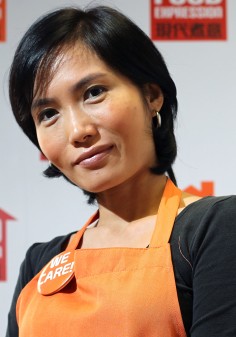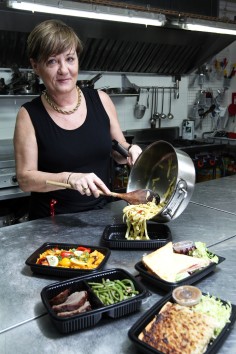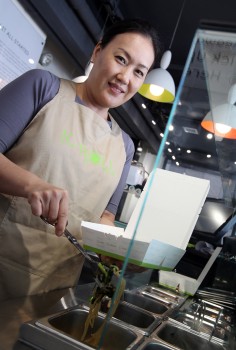
Tray chic: How lunchbox sets are going gourmet
Quality lunchbox sets are a hot food trend. Vanessa Yung goes in search of a square meal with a difference

THE TERM “BOXED MEAL” usually brings to mind low-quality food served in a styrofoam box, with the main aim of filling the stomach quickly and cheaply. But a number of local shops are working to upgrade the image by delivering a variety of better quality options.
“We use chicken stock instead of oil to stir fry our dishes. We never use MSG or preservatives and there’s no cornstarch in our kitchen. I personally can’t stand rice covered with the slimy sauce,” says Yvonne Lam Yee-ching of Food Expression.
A former design product management consultant, Lam says that born into a restaurateur family, she developed her palate for high-quality food by visiting restaurants around the world when she travelled for work.
Tucked one floor below the Airport check-in concourse at the Hong Kong station, the three-year-old Food Expression only does takeaway and deliveries.

Open only during the weekdays for four hours each day, the business caters to the lunchtime crowd. Most meals – 12 options each day, including four made-to-order wok-fried dishes such as stir-fried udon with mushrooms and truffle oil, and chicken-fried brown rice – sell out by closing time at 3.30pm. Its record was 500 lunch boxes sold in four hours.
Its boneless Hainan chicken rice is made of chicken soaked in home-made chicken stock and brine. Instead of mixing the rice with chicken oil and commercial Hainan chicken paste, lemon grass, garlic, ginger and chicken stock are used. The chicken comes with three different sauces that Lam concocted herself with inspiration taken from the version served at the Mandarin Oriental’s Café Causette, which she loves.
The popular bibimbap (mixed rice), which costumers can customise with accompaniments from the “chilli cart”, is derived from a recipe Lam got from a Korean friend with tweaks she made after a visit to Korea.
A fan of British chef Heston Blumenthal, Lam has invested in sous-vide equipment to experiment on new dishes.
The current one on the menu is Pho 60 degree, a noodle soup with slow-cooked beef brisket and a herby soup base made from a recipe Lam obtained from a Vietnamese friend. Only about 15 can be made each day, and they sometimes sell out within 15 minutes.
“Everything is made from scratch but served very hot and efficiently. All our meals have their own story – we give the food integrity. Everything’s fresh with lots of added value – it can be done even for fast food, although we have to put in a lot more effort. Quality must tag with a realistic price point, while keeping up with market trends is very important, too,” Lam says.

All dishes are made in the Chai Wan kitchen with ingredients that are flown in every two weeks from France before they are delivered to the two shops. At the Elements mall, customers can ask for their lunch box to be reheated, while at the Sheung Wan store a second-floor lounge – with microwave and oven facilities – is available so customers can eat in.
A long-time friend with owners Jean- Yves and Marie-Christine Chatté, German- French executive chef Sabine Rasse moved to Normandy in her early 20s. She married a Frenchman and learned family-style French cooking from her mother-in-law.
With dishes of boeuf bourguignon, veal blanquette, rabbit in wine sauce with pasta, duo of sole and salmon, and seafood and chicken paella, Rasse says, “We’re trying to show people the traditional dishes we’re eating in France. It’s not like at five-star restaurants where you have a tiny piece of meat with nice decorations.
You can eat French without spending a fortune. It’s really home-made food.”
While she says many of the dishes such as leek tart, quiche and croquemonsieur are better reheated in an oven, which many locals lack, the way she cooks the food and the fact that they did lots of testing and tastings beforehand, make sure the dishes still taste good after reheating in a microwave.

Ma Cuisine has also started offering a weekday all-you-can-eat salad bar featuring chicken, roast beef and salmon, alongside a wide range of greens, pickles and dressings, in response to demand from the increasing number of owners of art galleries in the area, and people who opt for healthier food.
If we had to pick a country which turns their boxed meals into an art form, it would be Japan, where bento box means tasty, balanced food beautifully presented.
Bento chain Hana-musubi, deepfried pork cutlet specialist Tonbe, and Sushi-land opened earlier this month on Causeway Bay’s Haven Street offering tasty, affordable bento boxes. JP Deli in Sheung Wan, however, is where the flavours are closest to the Japanese originals.
Started more than three years ago by Tomoko Akashi, JP Deli is a small shop with a few seats, and concentrates on takeaways and deliveries. “In Japan we have so many bento shops, but I didn’t see many in Hong Kong. So I thought working in Admiralty and many people [don’t have access to] good lunch places – there’s always a long queue and the prices are very high. It’s so difficult to book a restaurant,” says Akashi.

The small shop can sell more than 200 bentos in a day.
The star of the bento is the rice. Only Hitomebore rice from Japan is used. It is sweeter and stickier than Thai or Chinese rice.
The selftaught cook is proud of her home-made goodies – everything from the sauces to beef croquettes, ketchup-heavy rice omelettes, and the popular sakemarinated deep-fried chicken is made from scratch. The extensive menu also features a selection of donburi, curry rice or udon, and salads. Everything is simple, yet delicious.
K-Roll, also in Sheung Wan, is another that appeals with hearty home-made dishes. Founded in December by three mothers, coowner Grace Hwang Hea-un says people call it the “mummies’ shop”.
Hwang was inspired to open the shop when the kimbap (Korean rice rolls) she made for her seven-yearold daughter’s luncheswere so popular among her classmates that the box always came home empty.
“It’s home-style cooking. It’s kind of like a Korean Subway. We make everything here and everything’s done fresh. It’s healthy,” says Hwang.
“Our big selling point, I think, is the oil.
We use omega-9 sunflower oil. It’s 10 times more expensive than other oils but much healthier – zero trans-fat, very low saturated fat. It’s the same oil that the Four Seasons uses.”
Hwang says her shop has been well received as the food is great for busy, health-conscious people. Options like dukbokki (spicy rice cake), bibimbap and japchae (seafood noodles) are loved by Koreans and non-Koreans alike.
K-Roll sells K-box – a boxed meal which comes with rice, kimchi, stir-fried noodles and a choice of spicy pork, sautéed marinated beef (bulgogi) and grilled beef ribs (kalbi), as well as K-rolls (rice roll with bulgogi, tuna or crab salad), and KKorritos.
Bentopia in Admiralty is the place to go for a taste of Taiwan. Owner Danny Chan Ka-chuen says it may not be the most authentic or healthy option one can find, but the former banker and his wife’s take on Taiwanese food is an inexpensive and easy option.
Taiwanese food is their speciality, although half of the menu is taken up by Japanese dishes. The menu is very flexible, with a wide range of main dishes, side dishes and snacks to choose from for a customised box. A highlight is Taiwanese stewed-pork bento, which uses cubed pork belly, rather than the more common minced pork, for richer taste and texture.
Chan says he would love to open a new place, however he finds it difficult to hire staff. But both Food Expression and K-Roll have high hopes about their business and are opening new shops soon.
“We’ve received requests to open in Wong Chuk Hang and Kwun Tong. Some costumers who have moved from Central to Kwun Tong told me it is so hard to find quality lunch boxes,” says Lam of Food Expression, who will also be launching a range of handy cook-it-yourself kits for people to prepare a quick dinner at home.
“The market is actually very big, with Kowloon Bay, Kwai Chung and so on, on the list. Knowing the story behind our effort, people are willing to pay a little more. Even if it’s a boxed meal, you deserve better.”
